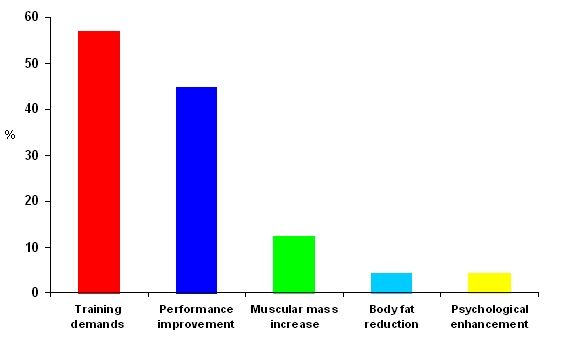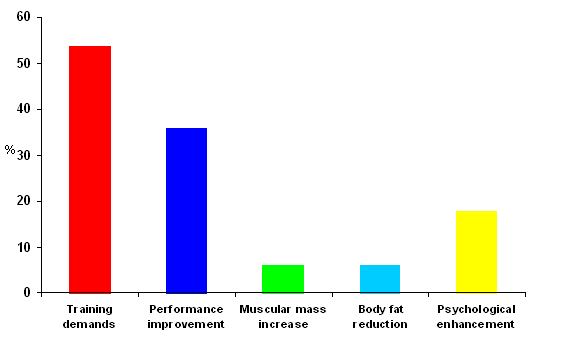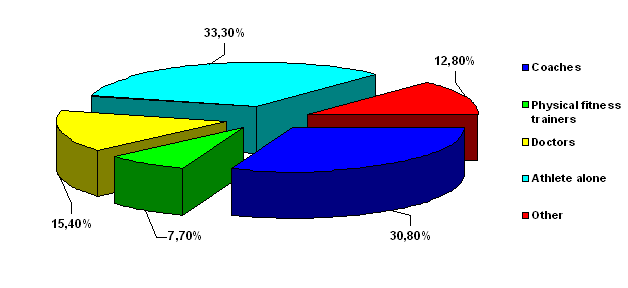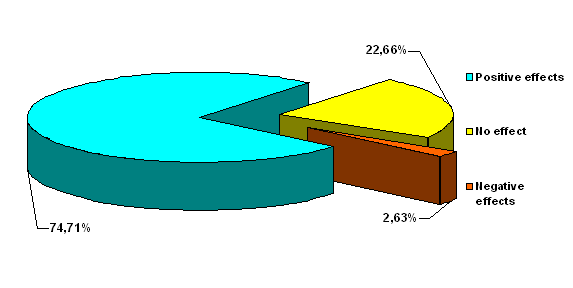Aristotle University of Thessaloniki
Department of Physical Education and Sport Sciences
Requests for reprints to:
George
Zaggelidis
85 , Elefterias Street,
57010 Pefka Thessaloniki, Greece
E Mail: gzangel@phed.auth.gr
|
ABSTRACT
The
purpose of this study was to examine dietary
supplement and ergogenic aids consumption by judo
athletes, the source of information
and suggestions, as well as their knowledge concerning side effects.
Sixty four judo athletes aged 24.3±1.4 years (40 male and 24
female) volunteered to participate in the study. A specifically
formed questionnaire, which contained questions relative to the
consumption of dietary supplements and
nutritional ergogenic
aids, the period and the reasons of their consumption, their
effects on performance and health, as well as to prohibited
substances intake, was
administered to all athletes. From the results it was found that
the
most frequently used dietary supplements and nutritional ergogenic
aids
were proteins (85.9%), calcium (85.9%), creatine (78.1%),
carbohydrates (75%), vitamins (75%), phosphor (70.3%), iron 68.8%),
potassium (60.9%), fats (50%), caffeine (50%) and sodium (46.9%). As
to water consumption 18.8% of athletes drank less than 1 liter per
day, 51.5% 1 to 2 liters and 29.7% drank more than 2 liters per day.
74.71% of judo athletes reported positive effects due to dietary
supplements consumption, 22.66% reported no effect, and 2.63%
reported negative effects. In conclusion, there
is a need for essential interventions
regarding the solution of the problem of judo athletes’ diet
and of dietary supplements and ergogenic aids consumption, as well as
of the
lack of information for their side effects.
Key words: judo athletes, dietary supplements, nutritional ergogenic aids
|
Introduction
Judo is a dynamic and complex sport, in which many variables, tactical, technical, physiological, and psychological, determine the final result (Frachini et al., 2005). Judo training sessions are normally 2 hours in duration and consist of judo specific skills and drills and randori (fighting practice). It is a sport characterized by short duration, high intensity and intermittent exercise that lasts in total 7.18 minutes per match (Degoutte et al., 2003).
Moreover, judo is a weight-class sport. This means that it is more advantageous for athletes to be as near as possible to the upper limits of his or her weight class. The emphasis on weight-classes obligates the judo athletes to focus closely on their weight and caloric intake (Boisseau et al., 2005). During a judo match, the primary source of energy is anaerobic glycolysis (Sikorski et al., 1987). Gariot et al., (1995) identified two profiles of judo athletes: (1) aerobic, represented by athletes who win in the final moments of the fight; (2) anaerobic, represented by athletes who win at the beginning of fight.
Supplements include non-pharmaceutical products such as herbal preparations, nutritional products and other supplements which may fall into either of the categories such as, dietary supplements (also known as food supplement or nutritional supplement), and nutritional ergogenic aids. Dietary supplements are ingredients added to the diet, mainly vitamins, minerals, amino acids, herbs or botanicals, and metabolites/constituents/extracts, or a combination of any of them. Dietary supplements can also be extracts or concentrates, and may be found in many forms such as tablets, capsules, soft gels, gel caps, liquids, or powders. Nutritional supplements are taken to meet the dietary needs of high performance athletes. Ergogenic aids are the products in this category and nutritional practice used to enhance performance, to improve exercise performance capacity and/or enhance training adaptations (Leutholtz & Kreder, 2001; Williams 1999). Nutritional ergogenic aids refer to substances that enhance performance and are either nutrients, metabolic by-products of nutrients, food (plant) extracts, or substances commonly found in foods (e.g., caffeine and creatine) that are provided in amounts more concentrated than commonly found in the natural food supply. Some sport nutrition specialists only consider a supplement ergogenic if studies show that the supplement significantly enhances exercise performance (Kreider et al 2004). Suitable information provided to the athletes on the issues of diet, as well as energy intakes that are required in judo, is a crucial and important factor for athletic performance.
Nutritional intake classifies foods as macronutrients and micronutrients. Carbohydrates fats and proteins are macronutrients that provide energy. Carbohydrates are the main source of energy for high intensity exercise and are essential for sustaining heavy training and athletic performance. Fats are consumed in prolonged and low intensity physical activities. Proteins are required for recovery from exercise and they reconstruct the muscles. Vitamins and minerals are the micronutrients essential for health but they do not provide energy (American Dietetic Association, 2000).
Nutrition alongside a systematic training program is vital to performance. Burns et al., (2004) found that adult athletes reported using vitamin and mineral supplements frequently were considered to have the highest impact on healing/ rehabilitation, while protein supplements and creatine were considered to have the highest perceived impact on sport performance. Other reasons for supplement use cited by adult and elite athletes include increased energy, enhanced performance, improved health, prevention of nutritional deficiencies, prevention of illness, increased muscle mass, and improved recovery (Erdman et al., 2006).
Dietary studies have indicated that there is an extreme variability in the dietary regimes of those looking for the optimum athletic diet. Many studies identified incorrect eating behaviors among athletes of different sports, dangerous weight loss practices and voluntary dehydration among wrestlers and judo athletes (Juzwiak & Lopez, 2004). Recent studies have shown that a great number of athletes using these substances are not well informed about the safety of these products, their ways of acting and their side effects (Kim & Keen, 1999; Cardoso et al., 1998; Silber, 1999). Little published scientific research is available on judo athletes. The nutritional habits of judo athletes and the energy intake that is required for their exercising is of great interest. Therefore, the purpose of this study was to examine elite judo athletes’ consumption of dietary supplements and ergogenic aids, and knowledge concerning the side effects of the consumption, as well as the persons who made the suggestion.
Methods
Participants
Sixty four judo athletes aged 24.3±1.4 years (40 male and 24 female) volunteered to participate in the study. Athletes’ training age was 9.67±6.24 years. The sample was competing in the Greek championship and subjects participated in all weight classes. Moreover, a written informed consent was obtained from each subject.
Measurements
A confidential and anonymous questionnaire was administered to all subjects. The questionnaire constituted of a modification of questionnaires used by Mason et al., (2001) and McGuine et al., (2001) and used after an adaptation to a Greek population. The questionnaire contained 18 questions that were categorized in 4 subgroups:
a) The first subgroup included 4 questions of general content: sex, age and years of pastime with sport activities.
b) The second subgroup included 4 questions regarding dietary supplements, nutritional ergogenic aids and the period of their consumption.
c) The third subgroup included 8 questions regarding the reasons of taking dietary supplements, persons who suggested the nutritional supplement consumption, nutritional ergogenic aids and the knowledge of their side effects.
d) The last subgroup included 3 questions regarding the consumption of prohibited substances by the athletes.
Statistics
For the statistical analysis the statistic packet SPSS/PC Version 12.0 for windows was used. The data analysis was done with the use of descriptive analysis.
Results
The majority of the athletes (75.5%) are not interested in their nutrition throughout the year, while a percentage of 37.5 follow a proper diet, especially in the pre-competition and competition period. A great percentage of the athletes (60.9%) use nutritional supplements during pre-competition (32.8%) and competition period (25.0%). Also a small percentage of athletes consume nutritional supplements when they feel overcome with fatigue. The reasons for nutritional supplements consumption are presented on Figure 1 and 2. As can be shown from the results of the multiple choice question, athletes consume nutritional supplements for different reasons (Figure 1 and 2).

Figure 1. Reasons for nutritional supplements consumption for men

Figure 2. Reasons for nutritional supplements consumption for women
In Figure 3, are presented the percentages of the persons who suggested the nutritional supplement consumption. As can be seen the decision to consume a nutritional supplement was due mainly to the athletes themselves or after their coaches’ suggestion. (Figure 3).

Figure 3. The persons who suggested the nutritional supplement consumption
Of all the judo athletes, 42.2% did not know the correct way to prepare fluid nutritional supplements according to their daily energetic demands. However, the majority of the athletes (60.9%) reported supplement consumption, against 39.1% who didn’t consume supplements. The most frequently used dietary supplements and nutritional ergogenic aids were proteins (85.9%), calcium (85.9%), creatine (78.1%), carbohydrates (75%), vitamins (75%), phosphor (70.3%), iron 68.8%), potassium (60.9%), fats (50%), caffeine (50%) and sodium (46.9%). As for water consumption, 18.8% of athletes drank less than 1 liter per day, 51.5% drank 1 to 2 liters and 29.7% drank more than 2 liters per day.
Figure 4 presents the percentages of supplement consumption effect. As can be seen, the biggest percentage of athletes experienced positive effects, another significant percentage had no effect, while the smallest percentage of athletes experienced negative effects concerning the nutritional supplement consumption.

Figure 4. Athletes’ supplement consumption effects
Most of the subjects (65.6%) were aware of the prohibited substances list. They, also, reported that usually judo athletes use vitamins, and creatine. Moreover, a small percentage of the athletes stated that they would consume prohibited substances in order to obtain economic profits (34.4%), better performance and glory (23.4%) and an occupational career (6.3%).
Discussion
From the analysis of the results it was found that Greek judo athletes, athletes with great experience, did not show particular interest in their nutrition, while only a small percentage took care about their diet, particularly at the pre-competition and competition period. This decreased interest, insufficient information and education may be due to the absence of special programs in the school and sport society. Moreover, a great percentage of judo athletes use dietary supplements and ergogenic aids during pre-competition and competition period. These percentages are similar to the results of previous studies regarding gymnastics athletes (Zaggelidis et al., 2005) and games players (Airstone et al., 2005).
The most important reasons for dietary supplements and ergogenic aids consumption were the improvement of performance and the demands of training. Women gave particular importance to appropriate diet for psychological reasons. These findings are in agreement with previous research (Berning, 1991). As for dietary supplements and ergogenic aids consumption, an important percentage of judo athletes decided alone, while a lesser percentage had significant influence from their coaches, doctors and physical fitness trainers. In agreement, Dunn at al., (2001) found that trainers had more influence on the attitudes, subjective norms and intentions for supplement consumption.
It appears, that judo athletes deal with nutrition issues with improvisation and frivolity. Although they do not have knowledge of nutritional issues, such as the dietary needs and products, as well as the energy requirements of their particular sport, they make thoughtless use of nutritional supplements. For all these reasons, it seems important to educate coaches and judo athletes in health nutrition and weight control practices to restrict weight, in order to avoid adverse effects in young participants’ growth and maturation. Scientists, physicians, dieticians, coaches, athletic administrators, trainers, and other health professionals should cooperate in order to change the attitudes that support harmful practices to athletes (Little at al., 2002).
With regard to macronutrients, it appeared that judo athletes mainly use proteins and carbohydrates, with fats in a smaller percentage. This is potentially due to the nature of judo, which requires increased muscular strength and endurance. For the afore mentioned reasons, an increased daily intake of proteins and carbohydrates (1.6-1.8 g/kg proteins and 7-8 g/kg carbohydrates a day), is proposed by various dietetic associations. Additionally, increased supplementation with soya protein (0.5 g/kg of body mass) was found to be beneficial to judo athletes (Laskowski & Antosiewicz, 2003). Increasing carbohydrate intake increases exercise time before exhaustion occurs. However, an excess of carbohydrate intake converts to fat (Bergman et al., 1999).
In the present research, a great percentage of athletes took creatine. Today, creatine monohydrate has become one of the most popular ergogenic sport supplements. A high percentage of the North American athletic population consumes oral doses of creatine on a daily basis (McGuine et al. 2001). Creatine supplementation increased the pool of metabolically-active creatine in muscle (Harris et al., 1992). At present, creatine monohydrate is the most extensively studied and clinically effective form of creatine for use in nutritional supplements in terms of muscle uptake and ability to increase high-intensity exercise capacity (Volek et al., 1997).
With regard to the use of micronutrients the most frequently used supplements, from judo athletes in the present study, were vitamins, calcium, phosphor, and iron. Vitamins function in the human body as metabolic regulators, influencing a number of physiological processes that are important to exercise or sport performance. Moreover, vitamins are involved in processing carbohydrate and fat for energy production, an important consideration during exercise of various intensities. Also vitamin B is essential to help the hemoglobin formation in red blood cells, a major determinant of oxygen delivery to the muscles during aerobic endurance exercise. Additionally, vitamins C and E function as antioxidants (Van Der Beek, 1991). Several sport nutrition experts suppose that athletes in weight control sports and those who, for one reason or another, do not follow a well-balanced diet may be at risk for vitamin deficiency (Benardot et al., 2001).
Judo athletes in the present study showed that they receive, in a large percentage, essential quantities of calcium. Calcium and phosphor are required for the health of bones and teeth, while 99% of calcium is found in the skeleton. Calcium and phosphor have great importance for muscular operation and other physiological activities. Calcium reduction increases the danger of fractures and osteoporosis. This may be especially significant for women who develop the female athlete triad that consists of disordered eating, amenorrhea and osteoporosis (Williams, 2005). Iron supplementation in athletes prone to iron deficiencies and/or anaemia has been reported to improve exercise capacity, while sodium phosphate loading has been reported to increase maximal oxygen uptake, anaerobic threshold, and improve endurance exercise capacity by 8 to 10% (Kreider et al., 2004).
Sobal and Marquart (1994), as well as Kim and Keen (1999) found the most frequent forms of vitamin/ minerals consumed tend to be vitamin C, multivitamins, iron, and calcium. These results coincide with a more recent study in which it was shown that the most commonly used supplements by adolescent athletes were multivitamins, vitamin C, and iron (Neiper, 2005). In a study of O’Dea (2003) it was found that the most frequently used nutritional supplement was sport drinks (56%) and secondly vitamin/mineral tablets (49%), followed by energy drinks (42%), herbal supplements (18%), guarana and creatine (5%), high protein milk supplements (4%), and coenzyme Q10 (1%).
According to their statement, a great percentage of judo athletes who took nutritional ergogenic aids had positive effects. A smaller percentage did not have any effect, while certain athletes declared that they had negative side effects. However, the excessive intake of certain ergogenic substances can lead to physical disturbances, such as diarrhoea, hindrance of amino-acids absorption and metabolism, as well as hindrance to free fat acids release, which is particularly important for energy production (Slavin at al., 1988). Many studies identified incorrect eating behaviors among athletes of different sport, dangerous weight loss practices and voluntary dehydration among wrestlers and judo players (Juzwiak & Lopez, 2004). Food and drink restrictions can induce a combined negative effect on physical and psychological capacities (Boisseau et al., 2005). However, it is remarkable that a percentage of judo athletes could make use of prohibited substances for extrinsic motivations such as economic profits, better performance, glory, and occupational career. For the change of these attitudes, athletes must be educated in athletic virtues and Olympic ideals.
For this purpose, sports dieticians could play a key role in educating judo athletes, parents and coaches regarding their unique nutritional requirements. Nutrition lectures should focus on energy balance through food intake, adapted on the special needs of the sport. In conclusion, a great number of judo athletes take nutritional ergogenic aids alongside their usual diet. Instead of taking supplements, athletes should look at more appropriate and physical alternatives, such as a balanced and healthy diet.
References
AMERICAN DIETETIC ASSOCIATION. (2000). Position of the American dietetic association, dieticians of Canada, and the American college of sports medicine: nutrition and athletic performance. Journal of the American Dietetic Association 100(12), 1543-1556.
AIRSTONE, M., FAGBEMI, S., & MORRIS, A. (2005). Dietary supplementation habits and knowledge of competitive athletes and games players. Journal of Sports Sciences, 23(2), 118-119.
BERGMAN, B., BUTTERFIELD G., WOLFEL E., CASAZZA G., LOPASCHUK G., & BROOKS G. (1999). Evaluation of exercise and training on muscle lipid metabolism. Am J Physiol Endocrinol Metab, 276(1), E106-17.
BERNARDOT, D., COLEMAN, E., CLARKSON, P. & MAMOREM, P. (2004). “Can vitamin supplement improve performance”? Gatorade Sport Science Institute. Sports Science Exchange Roundtable 45 (3).
BERNING, J., TROUP, J., VANHANDEL, P., DANIELS, J., & DANIELS, N. (1991). The nutritional habits of young adolescent swimmers. Int. J. Sport Nutr., 1(3), 240-248.
BOISSEAU, N, VERA-PEREZ, S. & POORTMANS, J. (2005). Food and fluid intake in adolescent female judo athletes before competition. Paediatric Exercise Science, 17, 62-71.
BURNS, R., SCHILLER, M., MERRICK, M. & WOLF, K. (2004). Intercollegiate student athlete use of nutritional supplements and the role of athletic trainers and dieticians in nutrition counselling. Journal of the American Dietetic Association, 104(2), 246-249.
CARDOSO, E., STAL, P. & HAGEN, K. (1998). “HFE mutations in patients with hereditary haemochromatosis in Sweden”. J Intern Med, 243, 203-208
DEGOUTTE, F., JOUANEL P., & FILAIRE, E. (2003). Energy demands during a judo match and recovery. British. Journal. Sports Medicine. 37, 245-249
DUNN, M., EDDY, J., WANG, M., NAGY, S, PERKO, M.& BARTEE, R. (2001). The influence of significant others on attitudes, subjective norms and intentions regarding dietary supplement use among adolescent athletes. Adolescence, 36, 583-91.
ERDMAN, K., FUNG, T. & REIMER, R. (2006). Influence of performance level on dietary supplementation in elite Canadian athletes. Medicine and Science in Sports and Exercise, 38(2), 349-356.
FRACHINI, E., TAKITO, M., ROMULO, C., & BERUZZI, M. (2005). Morphological, physiological, technical variables in high college judoists. Archives of Budo, 1, 1-7.
GARIOD, L., FAVRE-JUVIN A., NOVEL V., REUTENAUER H., MAJEAN H., & ROSSI, A. (1995). Evaluation du profit énergetique des judokas par spectroscopie RMN du P31. Science Sports 10, 201–207
HARRIS, RC., SODERLUND, K.& HULTMAN E.(1992). Elevation of creatine in resting and exercised muscle of normal subjects by creatine supplementation. Clin Sci., 83, 367-374.
JUZWIAK, C. & LOPEZ, F. (2004). Evaluation of nutrition knowledge and dietary recommendations by coaches of adolescent Brazilian athletes. International Journal of Sport Nutrition and Exercise Metabolism, 14, 222-235.
KIM, S. & KEEN, C. (1999). Patterns of vitamin/mineral supplement usage by adolescents attending athletic high schools in Korea. International Journal of Sport Nutrition, 9, 391-405.
KREIDER, B., ALMADA, A., ANTONIO, J., BROEDER, C., EARNEST, C., ET AL. (2004). Exercise & Sport Nutrition Review: Research & Recommendations. Sports Nutrition Review Journal, 1 (1) 1-44.
LASKOWSKI, R. & ANTOSIEWICZ, J. (2003). Increased adaptability of young judo sportsmen after protein supplementation. Journal of Sports Medicine and Physical Fitness, 43 (3), 342-346.
LENTHOLTZ, B. & KREDER R. (2001). Exercise and sport nutrition. In: Wilson T, & Temple N, eds. Nutritional health. Totowa, NJ: Humana Press, pp. 207-39.
LITTLE, J., PERRY D. &. VOLPE, S. (2002). Effect of nutrition supplement education on nutrition supplement knowledge among high school students from a low-income community. J. Comm. Health, 27, 433-50.
MASON, M., GIZA, M., CLAYTON, L., LONNING, J., & WILKERSON, R. (2001). Use of Nutritional supplements by high school football and volleyball Players. Iowa Orthopedic Journal, 21: 43-48.
MCGUINE, T., SULIVAN, J. & BERNHARDT, D. 2001. Creatine supplementation in high school football players. J Sports Med, 11(4), 247-253.
NIEPER, A. (2005). Nutritional supplement practices in UK junior national track and field athletes. British Journal of Sports Medicine, 39, 645-649.
O’DEA, J. (2003). Consumption of nutritional supplements among adolescents: usage and perceived benefits. Health Education Research, 18(1), 98-107.
SILBER, M. (1999)."Scientific facts behind creatine monohydrate as sport nutrition supplement." The Journal of Sports Medicine and Physical Fitness, 39, 179-88.
SIKORSKI, W., MICKIEWICZ, G., MAJLE, N. & LAKSA, C. (1989). Structure of the contest and work capacity of the judoist. In: Proceedings of the International Congress on Judo, “Contemporary Problems of Training and Judo Contest”, 9th – 11th November, Spala, Poland. Ed: Mickiewicz, G. 58-65.
SLAVIN, J., LANNERS, G., & ENGSTROM, M. (1988). Amino acid supplements: beneficial or risky? Physician and Sports medicine, 16(3), 221-224.
SOBAL, J. & MUNCIE, H. (1988). Vitamin/mineral supplements use among adolescents. Journal of Nutrition Education 20(6), 314-318.
WILLIAMS, M. (1999). Nutrition for Health, Fitness, and Sport. Dubuque, IA: ACB/McGraw-Hill.
WILLIAMS. M. (2005). Dietary Supplements and Sports Performance: Minerals. Journal of the International Society of Sports Nutrition, 2(1): 43-49. In: (www.sportsnutritionsociety.org)
VAN DER BEEK, E. (1991). Vitamin supplementation and physical exercise performance. Journal of Sport Sciences, 92,77-79.
VOLEK, J., KRAEMER, W., BUSH, J., BOETES, M., INCLEDON, T., CLARK, K., & LYNCH, J. (1997). Creatine supplementation enhances muscular performance during high-intensity resistance exercise. J Am. Diet. Assoc., 97(7), 765-770.
ZAGGELIDIS, S., MARTINIDIS, K., ZAGGELIDIS G. & MITROPOULOU T. (2005). Nutritional Supplements use in Elite Gymnasts. Physical training, (online), March. In: http://ejmas.com/pt/ptframe.htm